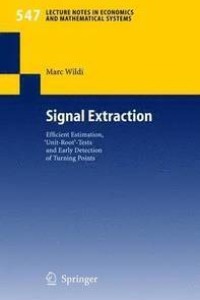
Liknande böcker
Signal Extraction : Efficient Estimation, ‘Unit Root'-Tests and Early Detection of Turning Points
Bok av Marc Wildi
The material contained in this book originated in interrogations about modern practice in time series analysis. * Why do we use models optimized with respect to one-step ahead foreca- ing performances for applications involving multi-step ahead forecasts? * Why do we infer 'long-term' properties (unit-roots) of an unknown process from statistics essentially based on short-term one-step ahead forecasting performances of particular time series models? * Are we able to detect turning-points of trend components earlier than with traditional signal extraction procedures? The link between 'signal extraction' and the first two questions above is not immediate at first sight. Signal extraction problems are often solved by su- ably designed symmetric filters. Towards the boundaries (t = 1 or t = N) of a time series a particular symmetric filter must be approximated by asymm- ric filters. The time series literature proposes an intuitively straightforward solution for solving this problem: * Stretch the observed time series by forecasts generated by a model. * Apply the symmetric filter to the extended time series. This approach is called 'model-based'. Obviously, the forecast-horizon grows with the length of the symmetric filter. Model-identification and estimation of unknown parameters are then related to the above first two questions. One may further ask, if this approximation problem and the way it is solved by model-based approaches are important topics for practical purposes? Consider some 'prominent' estimation problems: * The determination of the seasonally adjusted actual unemployment rate.







